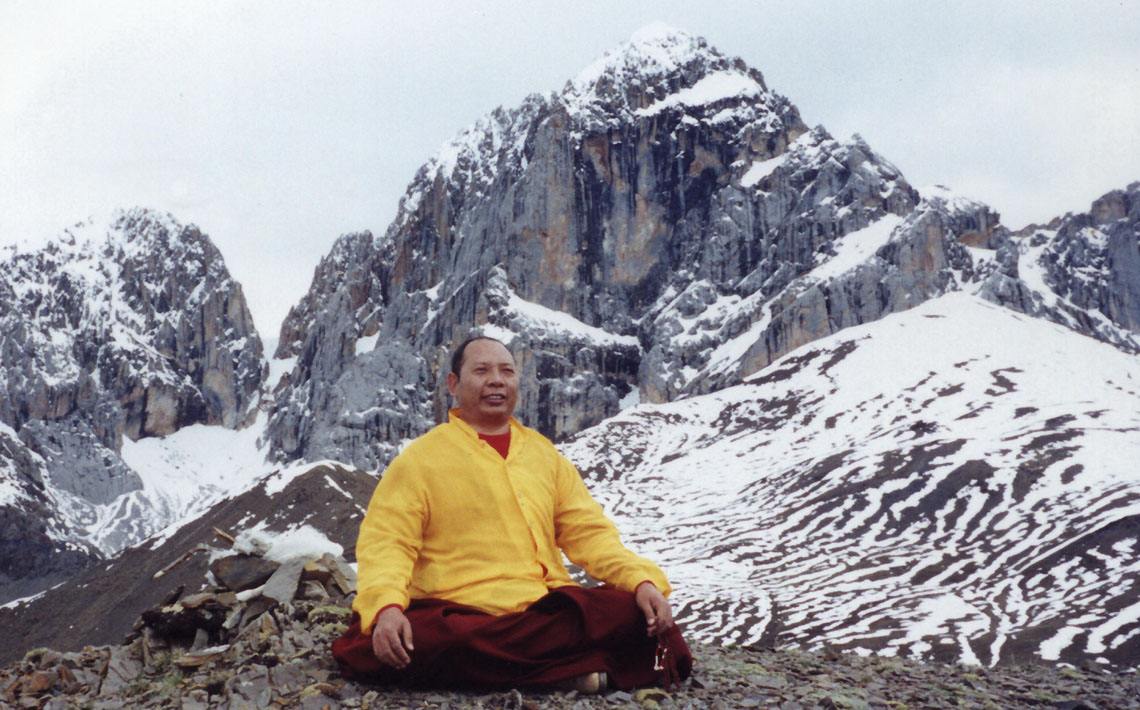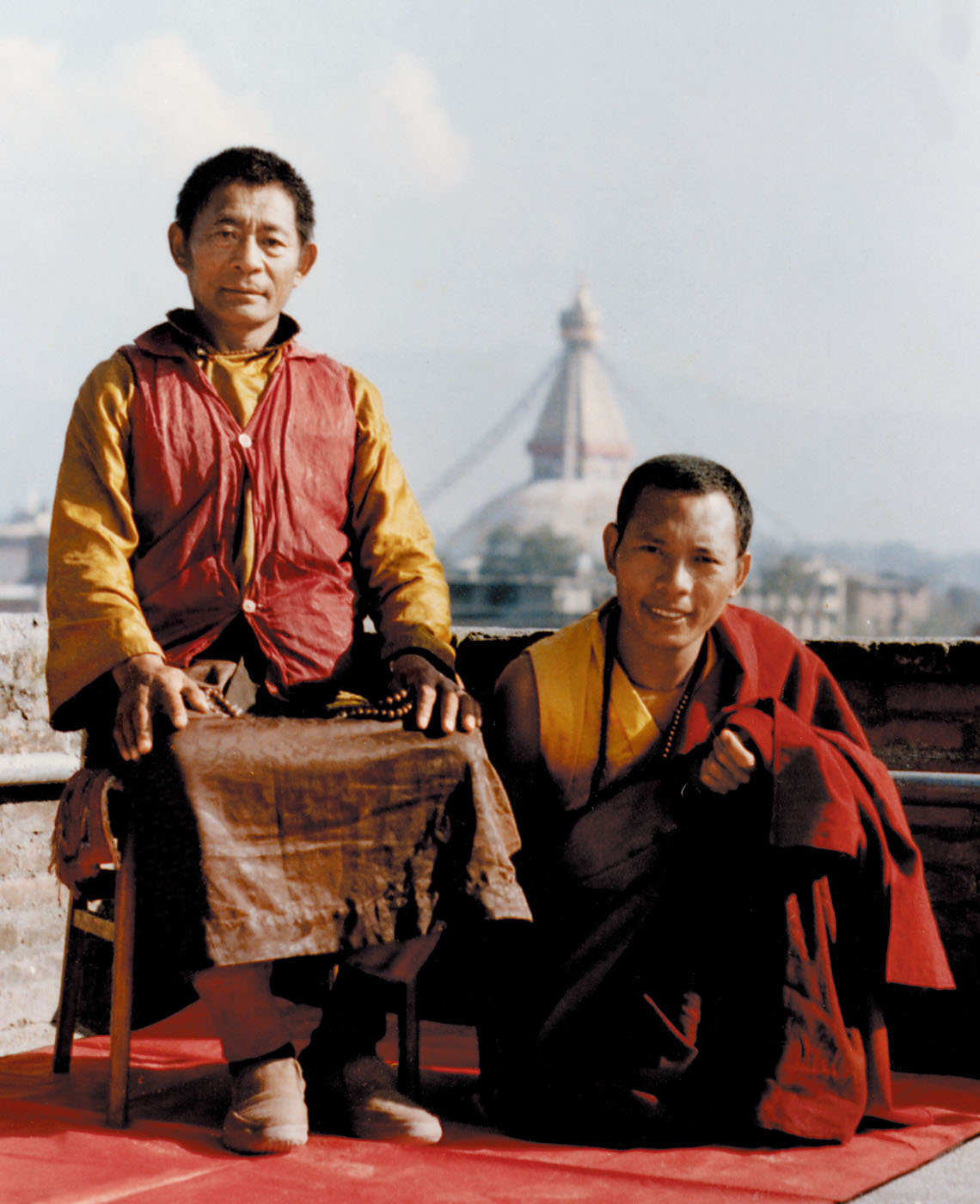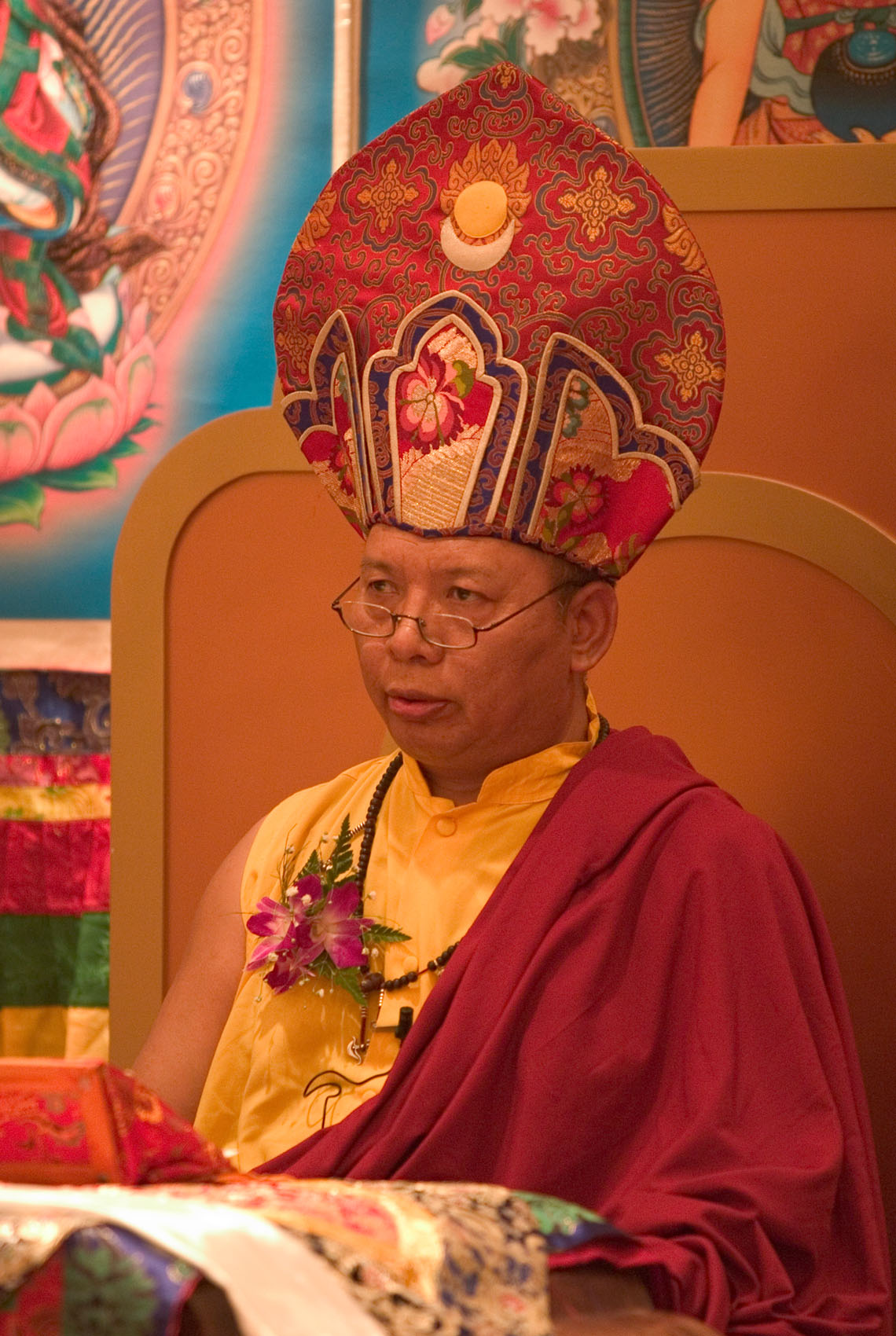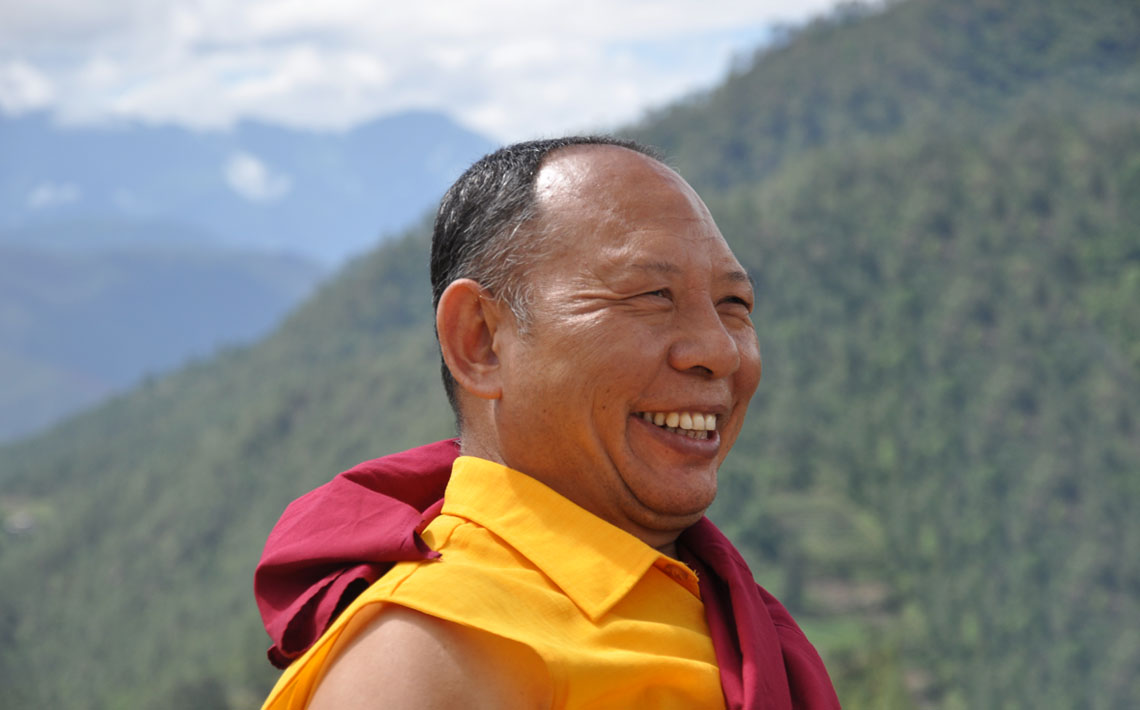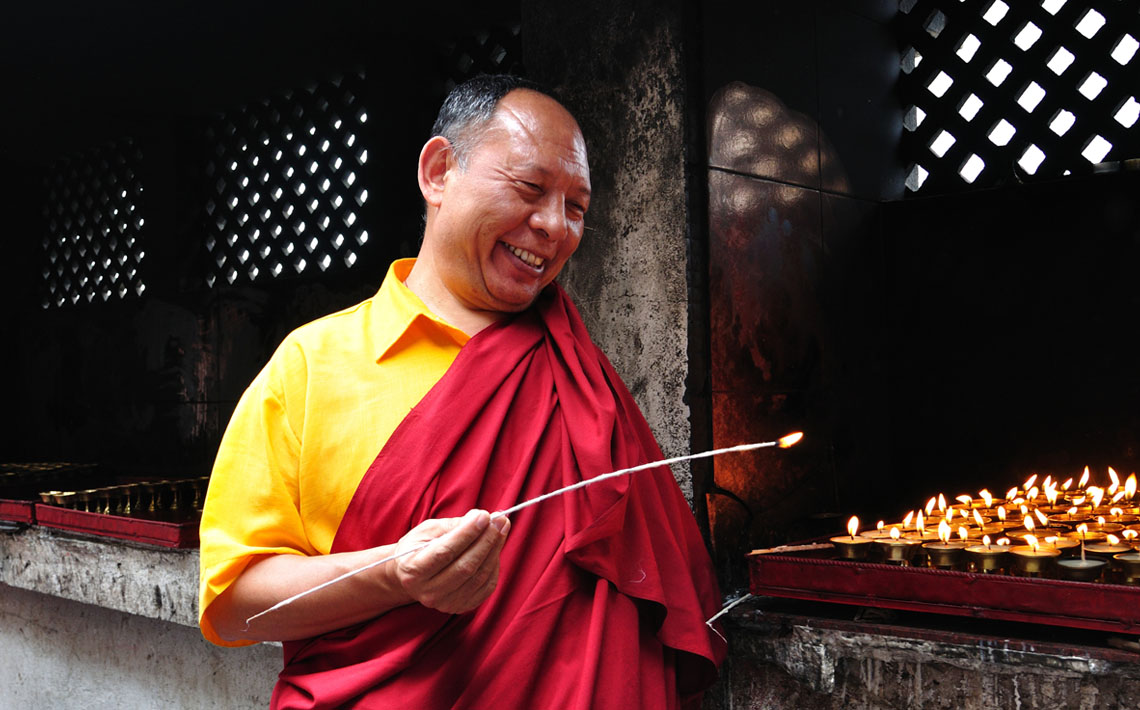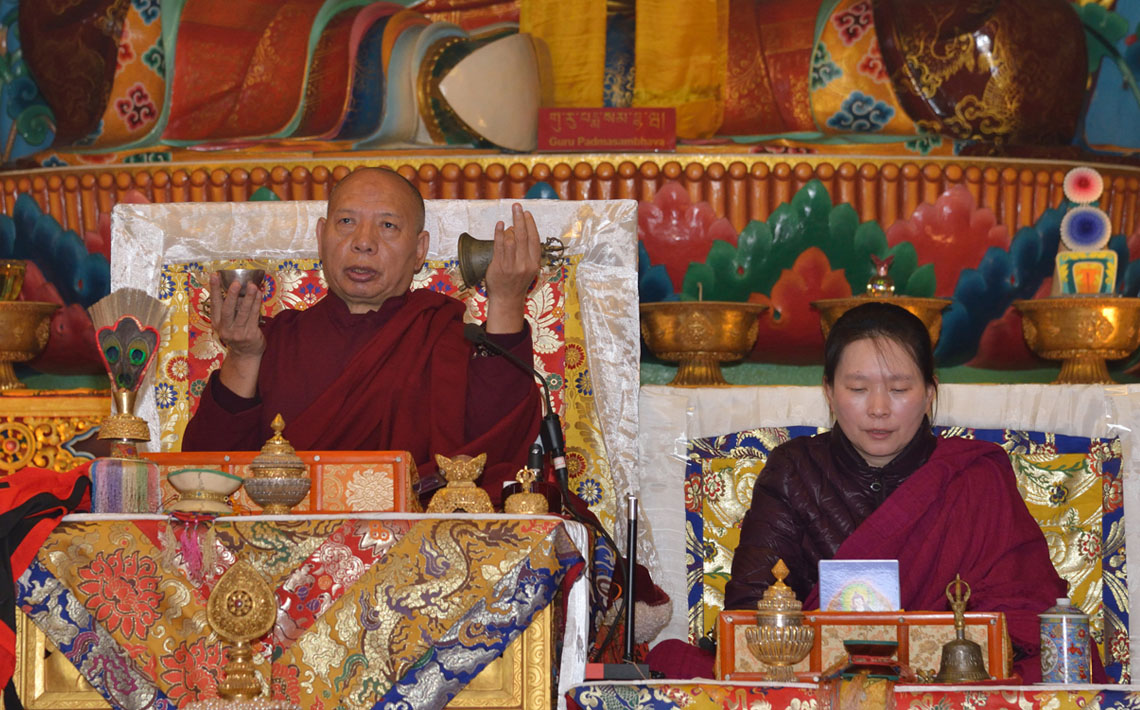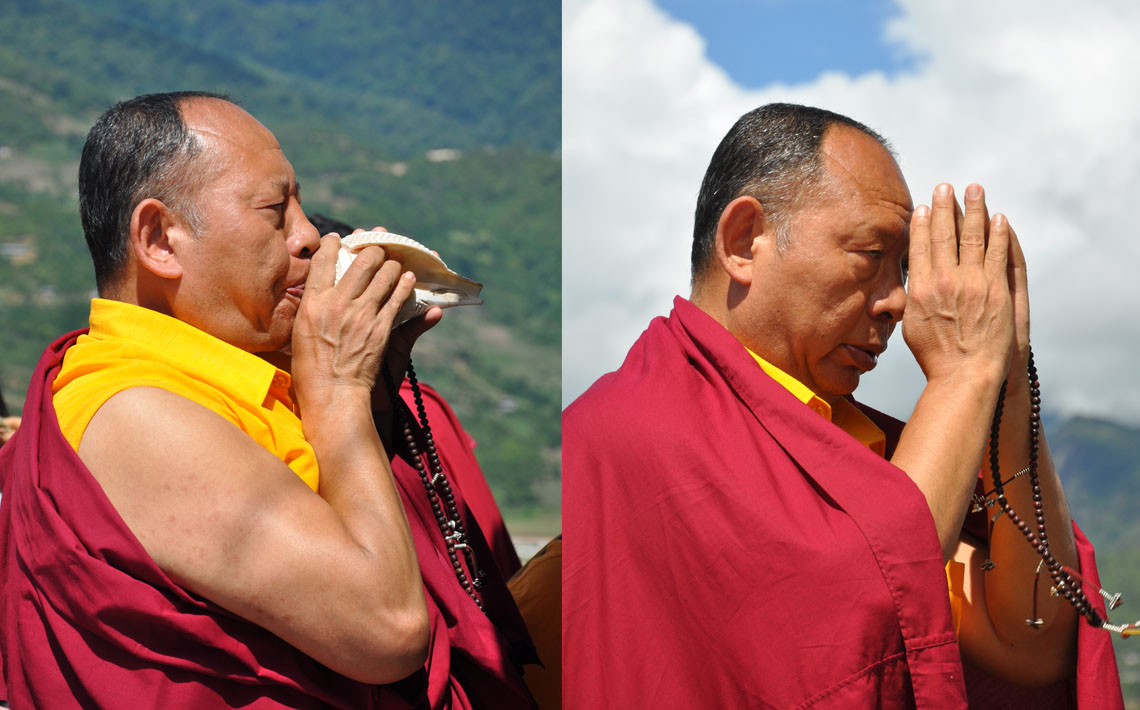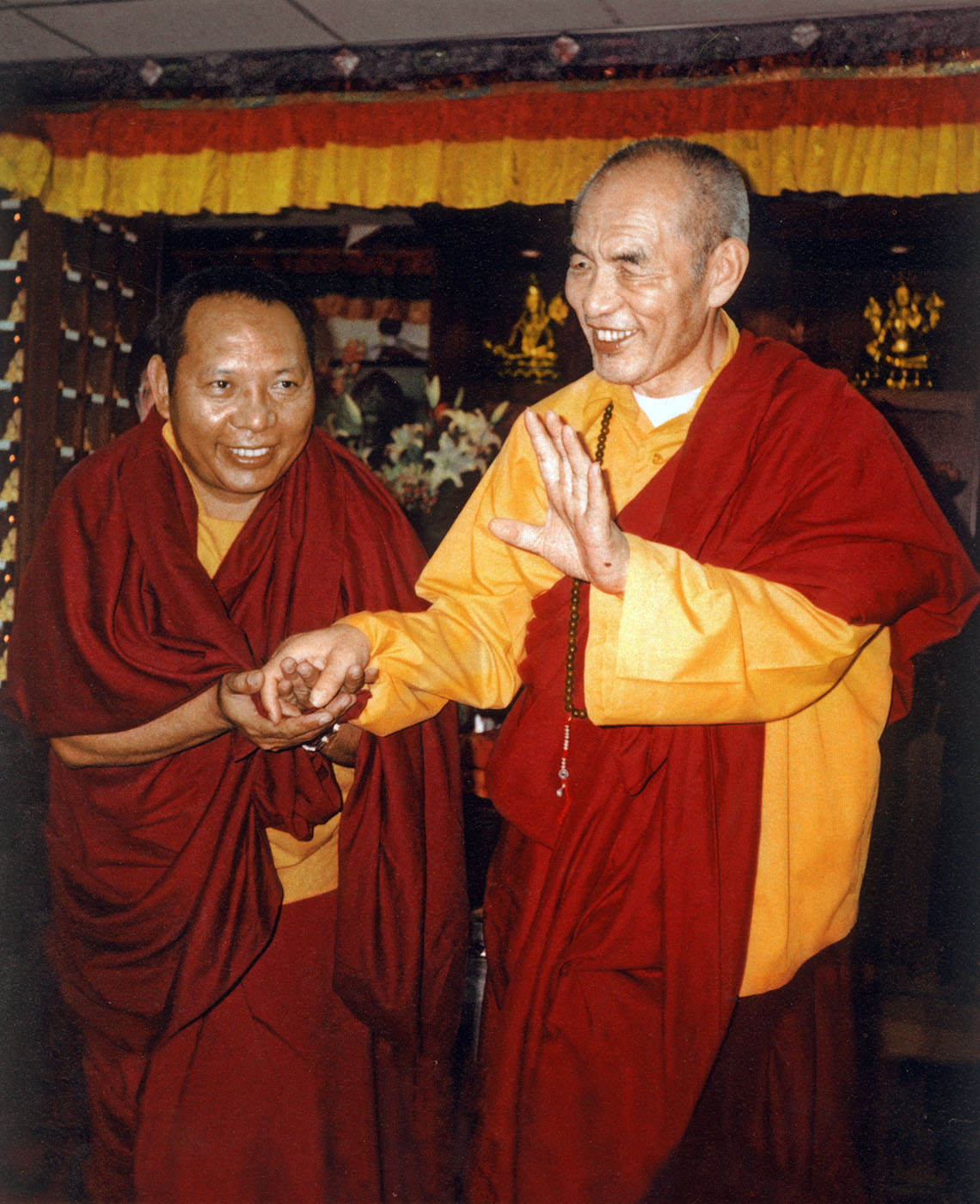T he venerable H.E. Yeshe Sangpo Rinpoche’s ancestry can be traced back to the ancient Tibetan emperor Drigum Tsenpo. Drigum Tsenpo had three sons: Shatrhi, Nyatrhi, and Jatrhi. Nyatrhi’s descendants, whomoved to the Kongpo area of Tibet, became the ancestors of Genghis Khan and our venerable H.E. Yeshe Sangpo Rinpoche. Even with the noble ancestry of Tibetan emperors, Rinpoche maintain a very modest and amiable disposition. Rinpoche said: “My grandfather used to say that a person of virtues, who benefits all sentient beings, need not rely on his family status to reach fame. The person of virtues resembles a diamond. Though hidden underneath the soils, the diamond still shines to the sky. For a person without the virtues to benefit all sentient beings, even with the most prominent family backgrounds, he or she acts like the garbage hanging around the sky, spreading all the stinking smells.”
In 1945, H.E. Yeshe Sangpo Rinpoche was born in a devout Buddhist family. His mother is Sherab Zangmo and his father is Tsultrim. Since early childhood, he manifested the disposition as an accomplished masters, as he learned the Tibetan language and studied scriptures effortlessly. With his mother’s earnest encouragements and strict supervision, Rinpoche recited sutras on a daily basis so that he could already memorize several important sutras in the very early childhood.
At the age of seven, Rinpoche took the monastic vows and studied under Kyangchak Rinpoche, one of the most accomplished Dzogchen masters. Rinpoche learned from Kyangchak Rinpoche the Tibetan grammar and ballads, applying himself to studying the philosophy and the foremost Vajrayana teachings. By the age of thirteen, he had completed the Five Hundred Thousand Ngondro (Preliminary Practice) and the Three Roots Practices. As such, Rinpoche had built the most important foundation for the Vajrayana practice in his early age, exhibited exceptional wisdom with congenital masterly manner, and paved the way for his becoming an accomplished Dzogchen master. Rinpoche followed and studied under Kyangchak Rinpoche for more than a decade, acquired all his heart essence and teachings, and thus inherited all the treasures of the Great Perfection teachings.
Later, in accordance with his master’s prophesy, Rinpoche furthered his Dharma studies in the Buddhist institute founded by H.H. the Second Dudjom Rinpoche, the successor of Guru Rinpoche and the supreme head and lineage holder of the Nyingmapa. Rinpoche received H.H. Dudjom Rinpoche’s empowerments and oral transmissions of the Kama lineage (the tradition of oral transmissions), and those of the Terma teachings (the treasure tradition) discovered by H.H. the Second Dudjom Rinpoche himself and his predecessors. Rinpoche graduated with the highest honor that surpassed all the previous graduates in the institute, and was honorably awarded the diploma by H.H. the Second Dudjom Rinpoche.
After graduation, in order to repay H.H. the Second Dudjom Rinpoche’s loving kindness and mentoring, Rinpoche served as the Khenpo of the institute for two years. During this period, he received teachings from the most renowned and accomplished Vajra masters, including H.H. Dilgo Khyentse Rinpoche, H.H. Dodrubchen Rinpoche, H.H. Nyoshul Khenpo Rinpoche, H.H. Chatral Rinpoche, and H.H. Dungse Thinley Norbu Rinpoche. He perfected all these teachings and achieved great realizations.
Later, with H.H. Dungse Thinley Norbu Rinpoche’s encouragement, Rinpoche assumed the great responsibility of Dharma promulgation for the benefits of all sentient beings. He founded the Samye Memorial Buddhist Vihara with the mission of fostering the Sangha, continuing the Buddhist heritage, fulfilling his master’s prophesies, and propagating Guru Rinpoche’s teachings.
To fulfill the root Guru’s will, the venerable H.E. Khandro Pema Chodron – Rinpoche’s Dakini prophesied by the root Guru and many lineage masters – assumed all the Dharma propagating activities together with H.E Yeshe Sangpo Rinpoche, except for the Samye Memorial Buddhists Vihara that was established long time ago. These incredible feats of Dharma propagating activities include the Samye Memorial Buddhists Monastery; Samye Memorial Buddhists Nunnery Vihara; Samye Memorial Primary Schools; Samye O-Sel Ling Long-term and Short-term Retreat Centers; the Five Grand Prayers Wheels and the Eight Stupas; the Samye Siddhi DungdrubㄖMonastery in Dolpo, Nepal (under construction); The Samten Choiling Monastery in Tho-Thong of the Himalayas (under construction); the Gyana Siddhi Ling Monastery and School in Karma-Rong (under construction); the renovation of the Urgyen Dongak Chöling Monastery (the Dudjom Gompa) and School housing the relics of the Second H.H. Dudjom Rinpoche; and the Samye Droldul-Ling Monastery in Penang, Malaysia. Rinpoche skillfully uses every means to benefits all sentient beings, leading them to the path of enlightenment. Rinpoche’s boundless Dharma activities have thus become disciples’ long-lasting spiritual pure lands.
So far, qualified Khenpos and Lopens, who graduated from the Samye Memorial Buddhists Vihara, have been invited to many places to benefit all sentient beings. They will carry out Rinpoche’s grand wishes and missions, i.e., to spread the Dudjom Tersar around the world.
Dzogchen, the great perfection, is the supreme teaching of the Nine Vehicles – Sravakayana, Pratyekabuddhayana, Boddhisattvayana (the Three Outer Vehicles), Kriya Tantra, Upa Tantra, Yoga Tantra (the Three Inner Vehicles), Mahayoga, Anuyoga, and Atiyoga (the Three Secret Vehicles). Unsurpassable and indescribable of its profoundness and preciousness, Dzogchen is the essence of all Buddha’s teachings, providing the means of attaining Buddhahood in a single lifetime.
To present, for the first time, a complete history of the Great Perfection lineage to all ethnic Chinese people, in 2001 H.E Yeshe Sangpo Rinpoche and H.E. Khandro Pema Chodron published the Chinese edition of the classic written by H.H. Nyoshul Khenpo Rinpoche: Blue Gem – History of the Dzogchen Lineage. This precious classic precisely documents the history of Dzogchen lineage, plays an important role in linking the past and the future of the Dzogchen lineage, and serves as an important basis for future practitioners to trace their Dharma lineages!
Dzogchen is the pith of all teachings! It is the profound teaching that directly leads practitioners to the Dharmadhatu! It is Buddha Samantabhadra’s secret mind treasure! It is the heart essence of Ten Thousand Dakinis! It is the Realization of One Hundred Thousand Accomplished Masters! Whoever learns the Dzogchen teachings will eliminate all obscurations and understand the true meaning of phenomena; whoever practices the Dzogchen teachings will liberate himself into the state of Dharmadhatu; whoever hears the explanations of the Dzogchen teachings from qualified masters will grow wisdom naturally, like the blossom of sacred lotus. Whoever reads the Dzogchen teachings will stay out of all worldly agonies and step into the path of liberations. The Dzogchen teachings are less difficult to practice yet achieve far greater merits; the Dzogchen teachings areprofound and significant. Practitioners of the Dzogchen teachings will naturally attain the rainbow body and youthful vase body in a single lifetime, achieving the ultimate Buddhahood!
In addition to the publication of Blue Gem—History of the Dzogchen Lineage written by H.H. Nyoshul Khenpo Rinpoche, H.E. Yeshe Sangpo Rinpoche and H.E. Khandro Pema Chodron completed the Chinese edition of the masterly work by H.H. Dungse Thinley Norbu Rinpoche – Ruby Rosary That Is Joyfully Accepted by Vidyadharas and Dakinis as the Ornament of a Necklace.This supreme classic will be in print in 2017 to fulfill the grand wishes of the guru, H.H. Dungse Thinley NorbuRinpoche.
This classic first explains the origin of Buddhism and how the Mahayana and Vajrayana teachings were developed and promulgated in India. It then describes, after the Buddhism was introduced into Tibet, how the pith of all Buddha’s teachings were incorporated and transformed into the Tibetan Buddhism, which is promulgated all over the world. The last part of this classic documents the biographies of all incarnations of H.H. Dudjom Rinpoche. For the benefits of all beings and practitioners to have a thorough understanding, this part describes how each incarnation of H.H. Dudjom Rinpoche benefits all sentient beings through different times with different identities. All incarnations of H.H. Dudjom Rinpoche are briefly described below:
1. In the August Colorful Pure Land at the time of Bhadra Kalpa, the first incarnation manifested as Maha Vidyadhara Nuden Dorje, who was also an incarnation of the Primordial Buddha.
2. In the time of Buddha Shakyamuni in India, the second incarnation manifested as Sariputta, one of Buddha Shakyamuni’s chief principles known for his intellectual wisdom.
3. In the City of Gold Decoration, India, the third incarnation manifested as the Great Brahmin Saraha.
4. The fourth incarnation manifested as Krishnadhara, the chief minister of King Indrabhuti of Oddiyana.
5. In Nepal, the fifth incarnation manifested as the great accomplished master Humkara.
6. In the time of Guru Rinpoche, the sixth incarnation manifested as the Drogben Khyeuchung Lotsawa, whosemerits and accomplishments are no different from those of Guru Rinpoche.
7. In India, the seventh incarnation manifested as the Pandita Smritijnana.
8. In the Lower Tsang Nalung Rong region of western Tibet, the eighth incarnation manifested as Rongdzom Mahapandita Chokyi Zangpo.
9. In Bhri Tsa Gang region of Amdo, Khams in Tibet, the ninth incarnation manifested as Katokpa Dampa Deshek.
10. In the Tsang Nyang Tod region of Tibet, the tenth incarnation manifested as Palden Ling Je Repa.
11. In Tibet, the eleventh incarnation manifested as Drogon Chogyel Phakpa, the leader of the Sakya lineage.
12. In Paro region of Bhutan, the twelfth incarnation manifested as Drum Gyi khar Nagpa.
13. In Sangan Drakar region of Domey, the thirteenth incarnation manifested as Hepa Chojung.
14. In Derge,Dokham, the fourteenth incarnation manifested as Rigdzin Düddul Dorje.
15. The fifteenth incarnation manifested as Gyalsey Sonam Detsen, the reincarnation of Rigdzin Düddul Dorje.
16. In Bhayul, Dokham , the sixteenth incarnation manifested as Dudul Rolpa Tsal.
17. In Da Chagkhung of the eastern part of Lower Dokham, the seventeenth incarnation manifested as Khrakhung Dudjom Lingpa.
18. In the Pemako region of Eastern Tibet, the eighteenth incarnation manifested as Dudjom Jigdral Yeshe Dorje.
19. The future incarnation will manifest as the King of Shambhala, Rigsdan Gyalpo Chagkhor Chen.
20. The last incarnation will manifest as the last of the One Thousand Buddhas, Buddha Aspiration, in the Age of Bhadra Kalpa.
The Chinese edition of these two extremely important and influential classics provides immense benefits and blessings to the readers. Readers of these two classics will clearly understand the sources of the profound Dzogchen and Dudjom Tersar teachings in Tibetan Buddhism, bringing all sentient beings ultimate benefits and happiness.
H.E. Yeshe Sangpo Rinpoche, also a prolific writer himself, has authored voluminous books on Buddha’s teachings as well as commentaries in Tibetan language and expounder in Chinese. These works will soon be in print.
The importance of a clean lineage to the Dharma, like that of the heart to the human body, cannot be overemphasized. Rinpoche’s Great Perfection lineage can be traced from H.H. Nyoshul Khenpo Rinpoche back to Samantabhadra (the Primordial Buddha). In this unbroken Dharma lineage, every lineage master is a realized practitioner and achieved the siddhi of the Dharmakaya. Following his root master –H.H. Nyoshul Khenpo Rinpoche – for almost thirty years, Rinpoche acquired all the pith instructions of the Great Perfection, mastered the means of attaining Buddhahood within a single lifetime, and became the lineage holder of this foremost doctrine and one of the most respected Vajra masters in Tibetan Buddhism.
Despite his inheritance of this supreme lineage, Rinpoche always remains modest. He once said, “I am just an ordinary Sangha. Like a piece of ordinary woods among the sandalwood trees, I am merely imbued with their greatness, emitting slight fragrance.” The sheer demonstration of Rinpoche’s simplicity and humility is his constant gratitude to lineage teachers while silent on his own greatness in his practice and realization of Dharma.
Rinpoche, with more than sixty years of Dharma practice experience, is a learned scholar and realized Dzogchen practitioner with inconceivably profound knowledge and accomplishments. His teachings are full of wisdom and yet easy to understand. He skillfully explains profound Dharma (especially Vajrayana teachings) in ordinary languages, thus benefiting innumerable beings.
Over the decades, Rinpoche’s footprints of Dharma promulgation branded in Nepal, India, Taiwan, the United States, Germany, Canada, Austria, Japan, Italy, Hong Kong, Malaysia, Singapore, and Indonesia. He gives teachings on a regular basis in Taiwan, Nepal, The United States, Malaysia, Singapore, and India. Even with his widespread fame, Rinpoche still maintains a very simple lifestyle. Nevertheless, his modesty can never conceal his eminence as an educator, a philosopher, and an accomplished master. This is our spiritual teacher — H.E. Yeshe Sangpo Rinpoche!





